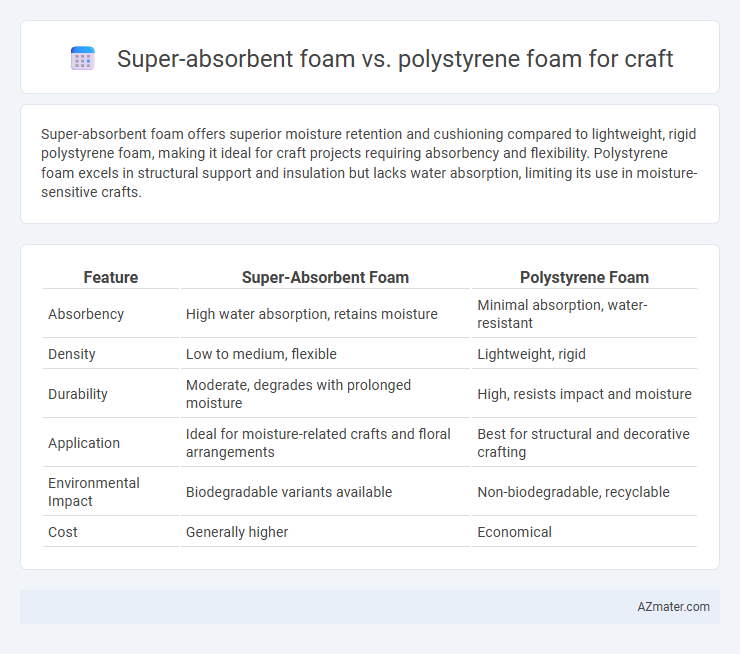Super-absorbent foam offers superior moisture retention and cushioning compared to lightweight, rigid polystyrene foam, making it ideal for craft projects requiring absorbency and flexibility. Polystyrene foam excels in structural support and insulation but lacks water absorption, limiting its use in moisture-sensitive crafts.
Table of Comparison
| Feature | Super-Absorbent Foam | Polystyrene Foam |
|---|---|---|
| Absorbency | High water absorption, retains moisture | Minimal absorption, water-resistant |
| Density | Low to medium, flexible | Lightweight, rigid |
| Durability | Moderate, degrades with prolonged moisture | High, resists impact and moisture |
| Application | Ideal for moisture-related crafts and floral arrangements | Best for structural and decorative crafting |
| Environmental Impact | Biodegradable variants available | Non-biodegradable, recyclable |
| Cost | Generally higher | Economical |
Introduction to Foam Types in Crafting
Super-absorbent foam and polystyrene foam are popular materials in crafting due to their distinct properties and applications. Super-absorbent foam excels at soaking up liquids, making it ideal for projects involving water or moisture management, while polystyrene foam is lightweight, rigid, and easy to shape, commonly used for structural components and insulation effects. Understanding these differences helps crafters select the right foam type for durability, texture, and functional needs in various creative projects.
What is Super-Absorbent Foam?
Super-absorbent foam is a highly porous material engineered to absorb and retain large volumes of liquid relative to its weight, making it ideal for craft projects that require moisture control or cushioning. Unlike polystyrene foam, which is primarily valued for its rigidity and insulation properties, super-absorbent foam excels in applications needing water retention, such as floral arrangements and sensory crafts. Its unique polymer structure enables efficient liquid absorption, enhancing durability and versatility in creative and practical uses.
What is Polystyrene Foam?
Polystyrene foam, commonly known as Styrofoam, is a lightweight, rigid material made from expanded polystyrene beads, widely used in crafts for its ease of cutting and shaping. Unlike super-absorbent foam, polystyrene foam does not absorb water, making it ideal for decorative projects that require structural support without moisture retention. Its thermal insulation properties and low density contribute to its popularity in model building, floral arrangements, and DIY crafts.
Key Differences Between Super-Absorbent and Polystyrene Foams
Super-absorbent foam excels in moisture retention and swelling capacity, making it ideal for applications requiring liquid absorption, unlike polystyrene foam which is lightweight, rigid, and primarily used for structural support and insulation in crafts. Polystyrene foam provides better thermal resistance and durability but lacks the water absorbency that characterizes super-absorbent foam's ability to hold many times its weight in fluid. Key differences include super-absorbent foam's porous microstructure suited for hydration purposes and polystyrene's closed-cell form that offers buoyancy and cushioning without liquid retention.
Absorbency and Moisture Retention Comparison
Super-absorbent foam excels in absorbency, capable of holding significant amounts of liquid relative to its weight, making it ideal for crafts requiring moisture retention and hydration. Polystyrene foam, by contrast, exhibits minimal absorbency and is primarily used for structural support and insulation rather than moisture management. The superior moisture retention properties of super-absorbent foam ensure prolonged dampness, which benefits projects involving plant care or gradual water release.
Durability and Structural Strength Analysis
Super-absorbent foam offers enhanced durability and resilience due to its ability to retain moisture and resist compression, making it suitable for crafts requiring long-lasting structural integrity. Polystyrene foam provides superior structural strength with its rigid and lightweight composition, but it can be brittle and prone to cracking under stress or impact. When comparing both, super-absorbent foam excels in flexibility and shock absorption, whereas polystyrene foam is favored for projects demanding firm, stable frameworks.
Crafting Applications: Best Uses for Each Foam
Super-absorbent foam excels in crafting applications requiring moisture retention, such as floral arrangements, plant displays, and water-activated art projects, due to its ability to hold large amounts of liquid. Polystyrene foam is ideal for structural and decorative crafts, including model building, costume accessories, and lightweight props, because of its rigidity, easy shaping, and paint-friendly surface. Choosing between these foams depends on whether the craft project prioritizes absorbency and moisture control or lightweight, sturdy construction with smooth finishing.
Environmental Impact: Biodegradability and Recycling
Super-absorbent foam typically offers better biodegradability compared to polystyrene foam, breaking down more efficiently in natural environments and reducing long-term waste accumulation. Polystyrene foam, known for its durability, presents significant recycling challenges due to its low density and contamination issues, resulting in limited recycling rates and persistent environmental pollution. Choosing super-absorbent foam for crafts can minimize ecological harm by enhancing compostability and supporting more sustainable waste management practices.
Safety Concerns and Handling Tips
Super-absorbent foam is non-toxic and hypoallergenic, making it safer for children and sensitive users compared to polystyrene foam, which can release harmful styrene vapors and may cause skin irritation. When handling super-absorbent foam, avoid direct contact with water or moisture to maintain its integrity, while polystyrene foam requires well-ventilated workspaces and protective gloves to minimize exposure to toxic fumes and dust. Proper disposal of polystyrene foam is essential due to its environmental impact, whereas super-absorbent foam is more eco-friendly but should still be discarded responsibly to prevent clogging drains or causing water retention issues.
Choosing the Right Foam for Your Crafting Project
Super-absorbent foam offers excellent moisture retention, making it ideal for floral arrangements and water-based crafts, while polystyrene foam provides superior structural support and lightweight properties for model-building and sculpting projects. Choosing the right foam depends on the project's requirements for absorbency, durability, and ease of shaping. Assessing factors like water retention, density, and finish will ensure your crafting project achieves optimal performance and aesthetic appeal.

Infographic: Super-absorbent foam vs Polystyrene foam for Craft
 azmater.com
azmater.com